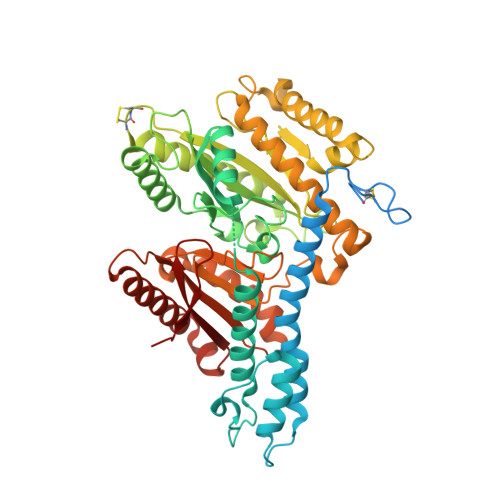The Structure of beta-carbonic anhydrase from the carboxysomal shell reveals a distinct subclass with one active site for the price of two.
Sawaya, M.R., Cannon, G.C., Heinhorst, S., Tanaka, S., Williams, E.B., Yeates, T.O., Kerfeld, C.A.(2006) J Biol Chem 281: 7546-7555
- PubMed: 16407248
- DOI: https://doi.org/10.1074/jbc.M510464200
- Primary Citation of Related Structures:
2FGY - PubMed Abstract:
CsoSCA (formerly CsoS3) is a bacterial carbonic anhydrase localized in the shell of a cellular microcompartment called the carboxysome, where it converts HCO(3)(-) to CO(2) for use in carbon fixation by ribulose-bisphosphate carboxylase/oxygenase (RuBisCO). CsoSCA lacks significant sequence similarity to any of the four known classes of carbonic anhydrase (alpha, beta, gamma, or delta), and so it was initially classified as belonging to a new class, epsilon. The crystal structure of CsoSCA from Halothiobacillus neapolitanus reveals that it is actually a representative member of a new subclass of beta-carbonic anhydrases, distinguished by a lack of active site pairing. Whereas a typical beta-carbonic anhydrase maintains a pair of active sites organized within a two-fold symmetric homodimer or pair of fused, homologous domains, the two domains in CsoSCA have diverged to the point that only one domain in the pair retains a viable active site. We suggest that this defunct and somewhat diminished domain has evolved a new function, specific to its carboxysomal environment. Despite the level of sequence divergence that separates CsoSCA from the other two subclasses of beta-carbonic anhydrases, there is a remarkable level of structural similarity among active site regions, which suggests a common catalytic mechanism for the interconversion of HCO(3)(-) and CO(2). Crystal packing analysis suggests that CsoSCA exists within the carboxysome shell either as a homodimer or as extended filaments.
Organizational Affiliation:
Molecular Biology Institute, University of California-Los Angeles, Los Angeles, CA 90095-1570, USA.















